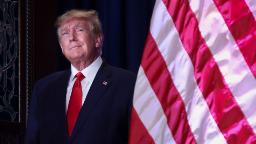[ad_1]

CNN
—
Former President Donald Trump on Friday proposed building up to 10 futuristic “freedom cities” on federal land, part of a plan that the 2024 presidential contender said would “create a new American future” in a country that has “lost its boldness.”
Commuters, meanwhile, could get around in flying cars, Trump said – an echo of “The Jetsons,” the classic cartoon about a family in a high-tech future society. Work to develop vertical takeoff and landing vehicles is already underway by major airlines, auto manufacturers and other companies, though widely seen as years away from reaching the market.
“I want to ensure that America, not China, leads this revolution in air mobility,” Trump, who announced his third bid for the presidency in November, said in a four-minute video detailing his plan.
He said he would launch a contest to charter up to 10 “freedom cities” roughly the size of Washington, DC, on undeveloped federal land.
“We’ll actually build new cities in our country again,” Trump said in the video. “These freedom cities will reopen the frontier, reignite American imagination, and give hundreds of thousands of young people and other people, all hardworking families, a new shot at home ownership and in fact, the American dream.”
Trump’s pitch comes the day before he is set to address the Conservative Political Action Conference in the Washington, DC, area, and as the 2024 Republican presidential field begins to take shape.
The proposal is the latest in a series of early policy offerings from Trump, who in recent weeks has also said he would seek to ramp up domestic energy production, adopt a more isolationist foreign policy stance and purge the government and military of “warmongers and globalists,” and undo a Biden executive order that would require government agencies to submit annual public plans aimed at promoting equity.
In December, the former president unveiled plans as part of his “free speech platform” that included vows to ban federal money from being used to label speech as misinformation or disinformation and to punish universities engaging in “censorship activities” with cuts to federal funding.
Trump did not elaborate Friday on how he would pay for his latest proposal – leaving unanswered what could be the biggest question as Republicans in Washington seek to curb federal spending. He also did not explain how some elements of his proposal differ from similar Democratic plans.
His plan, which was light on details, includes three additional planks: increasing tariffs on goods imported into the United States; providing families with “baby bonuses” that he said would “help launch a new baby boom”; and launching a beautification effort aimed at removing “ugly” buildings and revitalizing parks and public spaces.
Trump did not explain what “baby bonuses” would amount to or who would qualify. It’s not clear how his proposal differs from the enhanced child tax credit, which wasn’t extended beyond 2021. A group of Democratic lawmakers and progressive advocates tried – but failed – to have it included in the $1.7 trillion spending measure in December. That proposal was blocked by Republicans.
Trump on Friday also called for universal tariffs and imposing higher taxes on imported goods. He said he would escalate a trade battle with China, which he began during his four years in the White House. Doing so, he said, would jump-start American manufacturing.
President Joe Biden has left tariffs in place on $350 billion of Chinese goods – nearly two-thirds of what the US imports from China – which were imposed by Trump.
However, the costs of those tariffs are being passed on to American consumers, and contributing to inflation, experts say.
Treasury Secretary Janet Yellen said last year that those tariffs on Chinese goods have “imposed more harm on consumers and businesses” than on China.
Chris Rupkey, chief economist at markets research firm FwdBonds, said Trump’s proposed economic plan is reflective of the onetime real estate developer’s efforts before taking office.
“Builders build and make dreams a reality, but this plan looks like a stretch because the country cannot afford to undertake massive new projects when the national debt is over $31 trillion,” Rupkey said in an email. “There are some interesting ideas here, but this is not the right time for bold plans that dream big. There’s no money left in Uncle Sam’s till to pay for big dreams and daring projects.”
The nation is in the midst of a “cost-of-living crisis” that makes this too expensive of a proposition, Rupkey added.
[ad_2]
